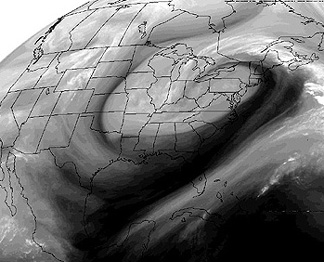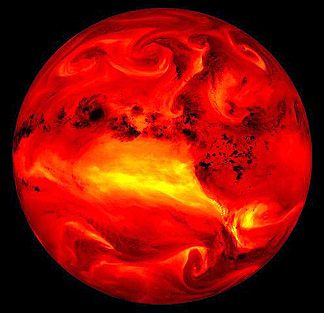

Rapid improvement in vidicon technology led to the first color
system, the MSSCC (Multicolor Spin Scan Cloud Camera), on ATS-3
(launched November 5, 1967, producing striking portraits of entire
continents such as this view of South America:
The beginning of an operational system dates to May 17, 1974 with
the launch of the first of two SMS's (Synchronous Meteorological
Satellite). Each carried as its principal sensor the VISSR (Visible
Infrared Spin Scan Radiometer). These were predecessors to NOAA's
GOES (Geostationary Operational Environomental Satellite) series
- the kingpin of present day geosynchronous systems covering the
western hemisphere. Here is an artist's drawing of the GOES-8
spacecraft:

GOES-1 was placed in an orbit that fixed it at 135° W soon after launch on October 16, 1975. Others were launched at two to three year intervals (coincidentally, GOES-10 was emplaced on April 25, 1997, the same day this paragraph was written). Those covering the Atlantic Ocean and the eastern U.S. are referred to as GOES-East; those in the Pacific are known as GOES-West). Again, VISSR is the chief sensor, but sounding (VAS is the VISSR Atmospheric Sounder) capabilities are also onboard. Starting with GOES-8 (April 13, 1994), the VISSR is operated 100% of the time rather than providing periodic views.
To exemplify GOES imagery, we now show the first visible image (top)
made from GOES-1 on October 26, 1975 and the first IR image (bottom) from
GOES-9 on June 19, 1995:


These hemispherical images can be subsetted to concentrate on
specific areas. Here are two GOES-8 (East) images: the top one
focuses on a large continental storm on March 20, 1994 whereas
the bottom one indicates the passage of a front off the Atlantic
coast on November 27, 1996:


The GOES-8 sounder has a visible band and 18 thermal bands, chosen
to be sensitive to temperature variations related to CO2, ozone, and water vapor at different levels in the atmosphere.
Each band can be converted into an image to which colors are assigned
to single out thermal differences, as demonstrated in this panel
of images taken on May 5, 1997.

Unusual color composites can be made from different channel images.
On the top is a colorized rendition of the 6.7 µm channel image
from GOES-8, sensitive to water vapor distribution, which highlights
a big U.S. storm on March 20, 1994. On the bottom is a false color
image made from the 6.7 µm = blue; 11 µm = green; visible = red;
this GOES image displays Hurricane Hugo as seen on September 21,
1989.


Code 935, Goddard Space Flight Center, NASA
Written by: Nicholas M. Short, Sr. email: nmshort@epix.net
and
Jon Robinson email: Jon.W.Robinson.1@gsfc.nasa.gov
Webmaster: Bill Dickinson Jr. email: rstwebmaster@gsti.com
Web Production: Christiane Robinson, Terri Ho and Nannette Fekete
Updated: 1999.03.15.